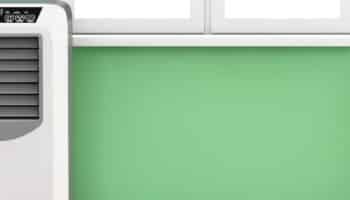We've independently reviewed this article to make sure it's as accurate as we can make it.
To find out more about our article creation and review process, check out our editorial guidelines.
Is your portable air conditioner leaking so much water, you think it might be a faucet?
If so, you’re in the right place. Thousands of people are stuck with a leaking portable ac, and thankfully there’s often some simple solutions to solve it.
To fix a leaking portable air conditioner, first check the water drainage. You might just need to empty it. If the portable air conditioner is leaking from a fault, you can try to fix the leak yourself (tips below) or contact the air conditioner manufacturer.
A leak in your portable air conditioner can mean many things. None of them good! It can be as simple as needing to empty the basin more often, to giving a faulty performance. And costing you more in energy bills each month. So let’s figure out how to tackle it together.
For those not in a rush – read on and I’ll walk you through each issue and solution one by one.
Drainage Types
Before we go any further, it’s important to understand the two drain types in a portable ac unit.
Dehumidifying is a vital part of any air conditioner. If hot and humid air is cooled but not dehumidified, we end up cool but clammy. It feels pretty horrible! So air conditioners all work to take moisture out of the air as they cool. And that moisture needs to be drained somewhere.
Any portable air conditioner will either be a manual-drain, an automatic-drain, or a self-evaporating model. For the last one, it doesn’t have any drainage so no need to worry for that.
Manual means that the water flows into a condensate tank, which you need to empty regularly. The portable AC should have a small icon showing when the tank is almost full, and it will refuse to dehumidify if the tank gets full. If the weather has been super-humid, the tank will be filling quickly and need emptied more often.
Alternatively, an automatically draining portable air conditioner will drain itself via a drain hose, either using a pump or just through gravity alone.
The easiest way to tell which model you have is by labelling on the model, and an easily detachable larger condensate tank on the manual models.
So You’ve Found A Leak. What Now?
Let’s take things step by step. Starting from the moment you notice a damp or wet patch around your air conditioner.
1. First, let’s drain it. If the AC is a manual drain, then unplug the cap and fully drain out of water. Make sure to have a container ready to collect the waterfall!
2. Inspect the unit. Look for any rust, excess grimes, and structural holes. Check the float detector in the water container. Is it obscured? Does it look like it’s working properly?
3. Assess. Leaks are either caused by overflow (super humid conditions, faulty float detector), a clogged drain, or a structural fault (rusted holes, structural cracks).
Now let’s go through each type of potential problem, and how to solve it.
Manual Drain: It Could Be Overflowing.
Want some good news? This is the easier problem to deal with.
Overflow can be from a few reasons. Including
- The float detector isn’t working. Every manual-drain air conditioner should track how full it’s basin is. When it’s at capacity, the air conditioner should shut off to prevent overflow. (And get your attention since it’s not working!). This can often be caused by:
- The unit not being level. The water level is at a slant, and the float is at the higher end. Meaning the lower end overflows. Simply get the unit level to fix this.
- The detector is obscured by grime, dirt, or some other thing. A quick clean and check that it can move properly is all you need.
- It otherwise plain isn’t working. This may be a more internal system problem, and you’ll need a technician’s help.
- Overuse and/or crazy conditions. Portable air conditioners can be gamechangers, but they can’t take on the world. If your AC has been running constantly on max, and the climate is super humid, then the unit is probably sweating out more water than a waterfall.
- There’s not much to fix here – it’s just the conditions. Your best bet is to MacGyver together a better drainage bucket. Try raising the unit up on props and placing a larger bucket/container below. Otherwise just make sure you’re draining the unit regularly.
Automatic Drainage: What About The Drain Line?
If you have a model that drains automatically, the problem could be with your drain line.
There’s a few common issues here. Some are easy to solve, others aren’t…
- Faulty plug/cap. This is the best option – the drain line simply isn’t sealed correctly. Just take off the plug or cap and place it back on properly to complete the seal.
- Clogged line. Over time, drains can naturally get blocked due to grime or debris. If the drain line is accessible – great! Just use a metal wire (with the AC off) to dislodge the blockage. If you can’t get access, you’ll need to call for backup from the manufacturer. One thing worth trying is adding a tablespoon of bleach around the clog or opening, and letting that sit for a few hours.
- Faulty line. If you’ve had the air conditioner for a good few years, the drain may have just sprung a structural leak. If you can find it – some duct tape might do the trick. Otherwise, it’s a call for the manufacturer, or a replacement ac part.
Structural Damage
One of the worst cases is a real structural leak. These can be caused by:
- Holes in basin. Every part wears away to some degree, but a severe result can be a hole through the water tank. Try your best to solve with a patch-repair, or some other way to stop the leaking. Or, if possible, replace the tank altogether.
- Cracks in the system. Cracks can be caused from overuse, moving around, or simply during manufacturing. There’s some horror stories of units being delivered with a hole drilled into the water basin! Again, try to patch repair and seal any cracks that you can. Simple window sealant can do the trick. But there’s not much we can do if that doesn’t work – other than get a replacement.
If you want to get any replacement part – or see how much one would cost – click to enter your model number in the search bar below. Our partners at AppliancePartsPros stock almost every part with free guides on how to install them.

Other Causes
Last up are two more miscellaneous faults than can cause water issues.
- Dirty air filter. If it’s been far too long since you’ve cleaned your air filter, this can cause a lot of internal condensation that looks like a leak out the bottom. Especially because the blocked airflow goes back over the evaporator and freezes the coils. All you need is to do what your manual says – clean the filter regularly! If it’s beyond saving, replacements are always available.
- Refrigerant leak. The other, much scarier, cause of frozen coils is a leak of the AC’s refrigerant. If water is leaking from somewhere inside, and the air conditioner sucks at cooling recently, you may have a refrigerant issue. Especially if ice has started to cover the coils. Another tell-tale sign is hearing fizzing/hissing from the back of the unit. If you believe this is what’s wrong, the only solution is to call the manufacturer. If it’s out of warranty, I’d start looking for a new model!
Wrap Up
A leak in your air conditioner is never a good sign. It means you’re probably not getting the most from your air conditioner, and potentially paying extra in energy bills.
I hope this quick guide has helped give you some ideas about what might have gone wrong, and solutions to try.
Wishing you and your air conditioner a leak-free future!
If this guide has helped you, please consider supporting us by checking out some of our related articles. The more time readers spend on the site, the better we’re supported thanks to Google and adverts.
Thanks for reading, and have a great day 🙂
Craig







